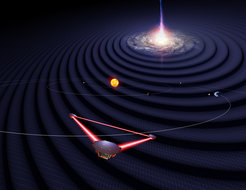US National Academy of Sciences highlights LISA as a New Window on the Dynamic Universe
A statement by the LISA Consortium
Today, the US National Academy of Sciences has noted the important presence in the NASA Program of Record for the implementation and execution of the Laser Interferometer Space Antenna (LISA) Mission, led by the European Space Agency (ESA). Through observations of gravitational waves, LISA will offer an unprecedented and unique view of the Universe, quite different from any other space telescope. LISA will deliver pioneering scientific results enabling insights not available through electromagnetic observations, and combining LISA observations with those of other ground- and space-based facilities, will also allow scientists to make enormous advances in multi-messenger astronomy.

In the Astrophysics Decadal Survey (Astro2020), a panel of experts evaluated and prioritized research activities in astronomy and astrophysics in the coming decade. The survey noted the “tremendous promise” of the future gravitational wave space mission LISA because of the expectation that observations of gravitational waves in space will make “astronomical measurements that will change paradigms.”
“The LISA Consortium appreciates that the National Academy of Sciences has recognized the groundbreaking potential of LISA. We are looking forward to continuing to work with our US Consortium colleagues to deliver the LISA mission for all the great science it can accomplish”, says Prof Karsten Danzmann,” Lead of the LISA Consortium, director at the Max Planck Institute for Gravitational Physics (Albert Einstein Institute) Hannover and director of the Institute for Gravitational Physics at Leibniz University Hannover.
The LISA instrument will consist of three spacecraft in a triangular configuration with 2.5 million kilometers (1.5 million mile) arms, moving in an Earth-like orbit around the Sun. Gravitational waves from sources throughout the Universe will produce slight oscillations in the arm lengths (smaller than the diameter of an atom). LISA will capture these motions and thus measure the gravitational waves by using laser links to monitor the displacements of test masses free-falling inside the spacecraft. The LISA satellites are being built by ESA, ESA member nations, and NASA.
LISA's hardware got its first and very successful test in space with ESA's LISA Pathfinder (LPF) with NASA participation. This included a thorough test of crucial components of LISA's technology. LPF demonstrated that the exquisite metrology needed for LISA meets the requirements and is ready for flight.
LISA will observe gravitational waves in a lower frequency band than that detectable by LIGO and Virgo allowing us to observe much larger systems at earlier times in the Universe’s history.
The LISA Consortium is a large international collaboration that combines the resources and expertise from scientists in many countries all over the world. Together with ESA and NASA, the LISA Consortium is working to bring the LISA Mission to fruition.












